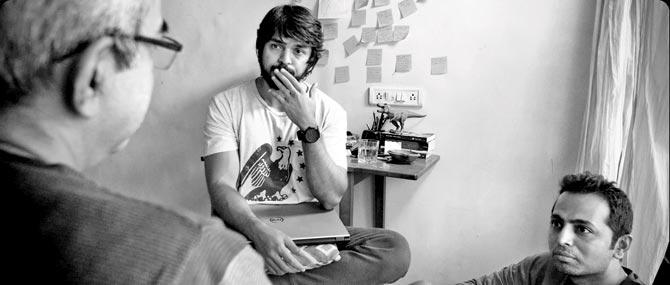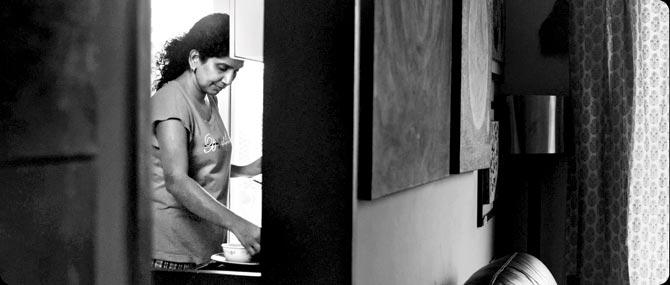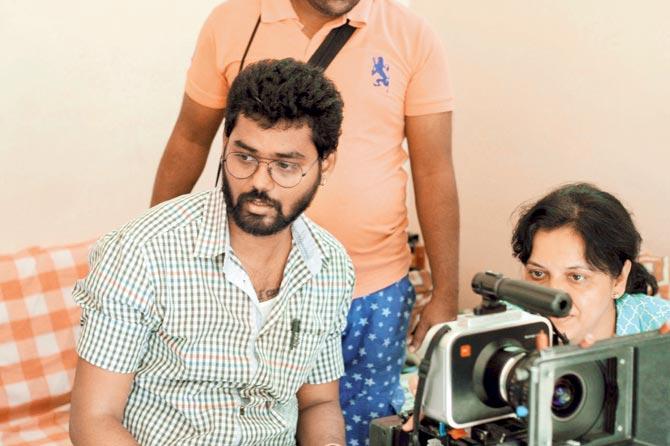Rohan Kanawade's new short film 'Khidkee' explores voyeurism and sexuality through the eyes of two neighbours who barely know each other

 Stills from Khidkee that is shot entirely in black and white
Stills from Khidkee that is shot entirely in black and white
It was on a sleepless bus ride from Nashik to Mumbai, when Rohan Kanawade conceptualised the story of 'Khidkee', a short film that he has just completed. The 30-year-old filmmaker, who shot to fame at the 2016 Kashish Mumbai International Queer Film Festival with his previous film Ektya Bhinti (2013), has taken a departure from the strong and explicit storytelling of that film, to explore the LGBTQ theme rather subtly in this one. The 39-minute long film that's set in Mumbai tells the story through the voyeuristic eyes of its two protagonists - a housewife and a screenwriter - who peep into each other's homes through their respective windows. What they see of each other is remarkably far removed from what the audience sees.
"The idea is to underline how reality often differs from perception, especially in matters of sexuality. People see someone dress or talk a certain way, and pat, conclusions are drawn," he says. But also, the story explores the idea of neighbours in a city like Mumbai - how little we know of our neighbours and how it's almost fashionable not to know them.

"When my partner and I moved into our current apartment, we'd have neighbours peeping. That, you could say, was the genesis of the thought behind Khidkee, which I must clarify is entirely a work of fiction - no autobiographical elements in it at all," Kanawade says. The story is told in two parts - one, from the point of view of Madhu, a middle-aged housewife whose life now revolves around taking care of her paralytic, bed-ridden husband. Her only distraction is Ashween, a young screenwriter who lives in the opposite building, who she watches through her window. His over-indulgence in alcohol and the constant flow of male guests raises her curiosity. Ashween, in turn, has his own idea about Madhu from the little he sees of her life through his window.
"Essentially, Khidkee to me is the eyes of my protagonists. But, there's also a third layer of voyeurism - the eyes of the audience for whom the screen becomes the khidkee through which they observe both characters. And, what the audience sees is totally different from what my protagonists do," Kanawade says. The camera too is a static setup, wherein only one portion of the house can be seen at a time, following the eyes of the voyeur.

Interestingly, sexuality as a theme doesn't find a loud exploration in the film. However, the elements are cleverly woven in, in a way that they cannot be missed. Ask him about the portrayal of homosexuality in regional cinema and he says, "I can talk about Marathi cinema and I can confidently say that there is barely any noteworthy work in this genre. That's why I want to make only Marathi films on LGBTQ subjects. People ask me why I don't make films in English. Why should I? When you see a Marathi-speaking lesbian in this film, it is bound to have a stronger impact than it would, in case of an English speaking one. Whether we like it or not, our minds are conditioned. We need to show that these characters are people from our own culture, and, therefore must not be relegated to the 'other'. I don't want to tell stories in Hindi or English. My stories will be most honest when in Marathi."
The filmmaker seems to have an affinity for black and white, and Khidkee, much like his previous work is shot entirely in monotone. "There are two aspects to this," he says. "The most boring, but most honest answer is that I love black and white. And, honestly, it is not easy to shoot in black and white because the lighting is a whole different ball game altogether. But, I also feel that black and white helps you concentrate on the emotions and the story, because the visual distractions are less. And, I believe that human emotions, the strongest kinds, are always either black or white."
Interestingly, Kanawade has had no formal training in filmmaking. "I studied to become an interior designer and that's what I was doing initially. But I had a strong love for films, and I would make random shorts in my free time. Then one day, a friend suggested we enter a competition, but the catch was that neither of us knew how to make a technically sound film. That's when I started learning the craft through YouTube tutorials. And that's how my tryst with filmmaking began," says Kanawade, whose banner is curiously titled Dark Films.
Initially, he would only make horror films. Explaining why, he says, "You see, I grew up in a chawl in Andheri and ghost stories are an integral part of chawl life - yahan bhoot hai, wahan bhoot hai. Funny as they were, they stuck in my mind and later found expression in my films. The name Dark Films, because they started off as horror, and now, they explore the dark or unseen side of human emotions."
 Subscribe today by clicking the link and stay updated with the latest news!" Click here!
Subscribe today by clicking the link and stay updated with the latest news!" Click here!









